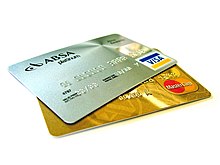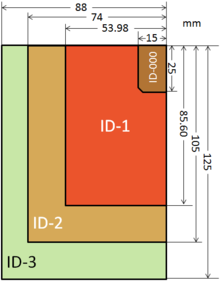ISO / IEC 7810
ISO / IEC 7810 is an international standard that defines four formats for identity documents - ID-1, ID-2, ID-3 and ID-000.
ID-1 ("credit card format")


The normalized first time in 1985 ID-1 format ( ID stands for English identification , identification ' ) corresponds to 85.60 mm (+0.05 mm / -0.06 mm) x 53.98 mm (+0.12 mm / - 0.13 mm). The thickness of the ID-1 format is defined as 0.76 mm (± 0.08 mm). Areas of application are e.g. B. Bank cards , credit cards , debit cards , driver's licenses or ID cards .
Include additional defined properties:
- ISO / IEC 7813 defines additional characteristics for plastic bank cards in ID-1 format, e.g. B. a thickness of 0.76 mm and rounded corners with a radius of 3.18 mm.
- ISO / IEC 7811 defines traditional techniques for storing data on cards in ID-1 format; H. embossed characters (so-called "embossing") and various methods of magnetic data storage.
- ISO / IEC 7816 defines ID-1 identity cards with contactless chips ( smart cards ) and contact chips for power, clock, reset and serial data signals.
- ISO / IEC 14443 defines identity cards with a contactless chip and a magnetic loop antenna with a frequency of 13.56 MHz ( RFID ). More recent standards of the International Organization for Civil Aviation ( ICAO ) for machine-readable travel documents specify a cryptographically signed file format and authentication protocol for the storage of biometric data (images of the face and fingerprints as well as the iris ) on ISO / IEC-14443 cards.
Other standards in this area are JIS-1 and JIS-2 .
swipe card
A magnetic stripe card ( English : Magnetic Stripe Cards , short Magstripe ) in ID-1 format can be up to three tracks (tracks) include:
- Track # 1: 79 alphanumeric characters (6 data bits each + 1 parity bit )
- Track # 2: 40 numeric characters (4 data bits + 1 parity bit )
- Track # 3: 107 numeric characters (4 data bits + 1 parity bit )
Maps can contain any subset of these tracks.
Track # 1
This track uses its own character set, which can easily be converted into ASCII by adding 32 (20 16 ) . The data on track # 1 is usually encoded as follows:
- 1 character "Sentinel", the start marker ("%")
- 1 character "Format Code", a format specification, for financial institutions "B" is used here
- up to 19 numeric characters " Primary Account Number " (contains e.g. the real account number at the bank)
- 1 character "Separator", a separator ("^")
- 3 numeric characters "Country Code", a country code if the Primary Account Number starts with "59"
- Surname
- 1 separator ("/")
- First name
- optional: 1 separator ("") followed by a second first name and / or title
- 1 separator ("^")
- 4 characters for validity date (YYMM), or separator
- Additional user data for the publisher's own purposes
- 1 end character ("?")
- LRC security code (The bitwise XOR sum for the entire track must result in 0.)
Track # 2
This track uses its own character set, which can be easily converted into ASCII by adding 48 (30 16 ) . This addition ensures that the bit value 0 is mapped to the "0" character. The data on track # 2 are mostly coded as follows:
- 1 start character ";"
- up to 19 characters "Primary Account Number"
- 1 separator "="
- 3-character country code if the primary account number begins with "59"
- 4 characters for validity date (YYMM), or separator
- further user data for the publisher's own purposes
- 1 end character "?"
- LRC security code
- Sample track
- 47110815 = 061247110815? C
Track # 3
In contrast to the first two, this track can be written on, its format is not defined in more detail apart from the start character, end character and security code (as with track # 2). Some banks use it to store encrypted PIN information here.
ID-2
The ID-2 format has a size of 105 mm × 74 mm; this corresponds to the DIN A7 format . It found z. E.g. for the German identity card , which was issued upon application by the end of October 2010. Visa labels are often in ID-2 format so that they can be stuck into passports with ease. Numerous ID cards, for example the ID card of the Bavarian Police , have the ID-2 format.
ID-3
The ID-3 format has a size of 125 mm × 88 mm; this corresponds to the DIN B7 format. This format determines the size of passports worldwide . It should be noted that passports with a flexible envelope (e.g. the Swiss passport ) usually correspond exactly to the ID-3 format; for passports with a rigid envelope (e.g. the Austrian or German passport ) the inside pages are in ID-3 format, while the envelope protrudes approx. 2 mm. Visa labels are somewhat smaller than the ID-3 format (mostly in the ID-2 format), and a. to enable problem-free gluing.
According to an agreement between the ISO and the International Organization for Civil Aviation (ICAO), standards for machine-readable travel documents are primarily developed by the ICAO, with the cooperation and advice provided by the ISO through membership in the technical advisory group for machine-readable travel documents (Technical Advisory Group on MRTDs ) is secured. As soon as a change or addition to the relevant standards in ICAO document 9303 has been decided, it will be decided by ISO in a fast-track process. The main source of information regarding machine readable travel document standards is therefore the ICAO, not the ISO.
The ICAO document 9303 determines in part 1 the formats for machine-readable travel documents. The 6th edition of Part 1 of the document was published by the ICAO in 2006 and consists of two volumes: The first volume describes " Passports with machine-readable data in text recognition format ", the second volume describes " Specifications for electronic passports with biometric identification capabilities " using embedded RFID chips. The 7th edition of ICAO document 9303 has been available since 2015 and contains specifications for machine-readable passports, visas and ID cards.
ID-000
The ID-000 format has a size of 25 mm × 15 mm. This format is mainly used for SIM cards in mobile phones and is called mini SIM there.
Web links
- CyberD (UK) Ltd: ISO Magnetic Stripe Card Standards
- MemeBridge: Data Layout on Magnetic Stripe Cards , Tech FAQ
- L. Padilla: Magnetic stripe reader / writer
- ISO / IEC 7810: 2003. Identification cards - physical characteristics. in the ISO catalog
Individual evidence
- ↑ Wolfgang Rankl, Wolfgang Effing: Handbook of the chip cards: structure, functionality, use. 5th revised and expanded edition. Hanser, Munich 2008, ISBN 978-3-446-40402-1 , p. 32.
- ↑ International Civil Aviation Organization (Ed.): Machine Readable Travel Documents . Doc 9303, Part 1: Machine Readable Passports - Volume 1, Passports with Machine Readable Data Stored in Optical Character Recognition Format. 6th edition. Montréal, Quebec, Canada 2006, ISBN 92-9194-753-9 ( PDF; 1.03 MB (Wayback link) ( Memento of May 1, 2015 in the Internet Archive ) [accessed March 1, 2016]).
- ↑ International Civil Aviation Organization (Ed.): Machine Readable Travel Documents . Doc 9303, Part 1: Machine Readable Passports - Volume 2, Specifications for Electronically Enabled Passports with Biometric Identification Capability. 6th edition. Montréal, Quebec, Canada 2006, ISBN 92-9194-757-1 ( PDF; 832 kB (Wayback-Link) ( memento June 5, 2015 in the Internet Archive ) [accessed March 1, 2016]). Machine Readable Travel Documents ( Memento of the original from June 5, 2015 in the Internet Archive ) Info: The archive link was inserted automatically and has not yet been checked. Please check the original and archive link according to the instructions and then remove this notice.
- ↑ International Civil Aviation Organization (Ed.): Machine Readable Travel Documents . Doc 9303. 7th edition. Montréal, Quebec, Canada 2015, ISBN 978-92-9249-790-3 ( online version [accessed March 1, 2016]).





